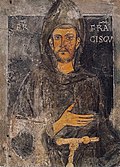You can help expand this article with text translated from the corresponding article in Italian. (January 2023)Click [show] for important translation instructions.
|
| St Francis in Meditation | |
|---|---|
 | |
| Artist | Caravaggio |
| Year | c. 1604-1610 |
| Medium | Oil on canvas |
| Dimensions | 130 cm× 90 cm(51 in× 35 in) |
| Location | Museo Civico Ala Ponzone, Cremona |
Saint Francis in Meditation (c. 1604/06 or 1607/10) is a painting by the Italian Baroque master Caravaggio in the Museo Civico, Cremona.
Contents
This is one of two paintings of almost identical measurements by Caravaggio showing Saint Francis of Assisi contemplating a skull (see Saint Francis in Prayer ). Neither is documented and both are disputed, although the dispute is as to whether they are originals or copies. The dating of both is highly uncertain, although the cypress trunk behind this Saint Francis is very reminiscent of the tree behind the Corsini John the Baptist .
